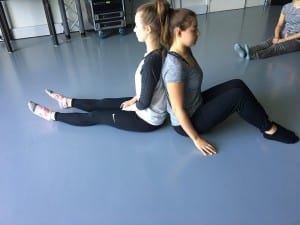Did you think we can ever be still? ‘Small Dance’ a video by Steve Paxton, shows that there is no such thing as being still in the body. The video shows a skeleton, the lines on the video help you to see the small movements which happen either on the inside or the outside of the body, you may not notice these happening. The only time you begin to notice these movements is when you really channel into your inner self and focus on tracking through your body. I find this a really good way to relax the body and mind ready for this kind of lesson.
Our research question was ‘how does sensory knowledge impact the way we communicate through contact improvisation?’ this came from week two when we were exploring touch and how it effects our communication. “To explore the complex intermingling of experience, perception and knowledge in relation to our human understandings of touch.” (Bannon and Holt, 2012, 215)
Our first task for the group was the ‘Banana Roll’ (IntegrationTraining, 2013) we got this idea after researching different ideas of how to introduce touch in contact improvisation. We found this video helpful and that it related to our idea as it is all about sensory knowledge and how it can impact the way we communicate through contact improvisation. We asked the group if they found it challenging or easy to release the body and letting your partner control what you were doing, the response was challenging, because they knew what they were doing and tried to roll themselves, however they all enjoyed it. One pair stuck out to me the most as the person being rolled was really relaxed and just let themselves go which was the purpose of the exercise. The next question we asked them was ‘were you able to sense what areas of your body were making contact with the floor?’ and they said it was hard to concentrate on the touch of the floor and the touch of their partner rolling them across the room.
The final exercise we explored was called ‘Sensorium’ another word for sensory perception – “the area of the brain considered responsible for receiving and integrating sensations from the outside world” (Farlex, 2003). ‘Sensorium’ was used to explore different ways of moving whilst in contact with someone with a large area of the body, the areas we used were shoulder to hip, hip to knee, knee to ankle and the try exploring connecting other ideas such as shoulder to knee, hip to ankle. When we asked if they and what sensations they felt when tracking through their bodies they said they could not do it as they were too focused on not separating from their partners. Our final question was, ‘do you have a better awareness of how sensory knowledge transmits through the body?’. Some people said yes as they found it difficult, but if they feel themselves going into habitual movements then they can think back to this task and try to explore it in more depth, however other people in the group said no as they found it hard to read each other’s movements so did not know where they were going.
I feel that we explored our research lab well, as we challenged the class and pushed them to find different ways of moving especially when they got stuck in certain places, they tried to carry on exploring them. This also helps to move away from habitual movement as you are unable to do them whilst connected to another body as you have to take them into consideration.
During our third Thursday night ‘improv jam’ session, we started out by learning weight bearing movements, however during the warm up for this I hurt my back, so was not comfortable to lift or be lifted. Once we had learnt different ways of weight bearing we started the jam…For me I really struggled to get into the jam because I felt like when we came into contact with someone they just wanted to lift or be lifted and I was struggling to do that, so unfortunately I did not go in to the jam as much as I had hoped to. Another reason I felt set back was because of two third year students being there, this is because they do not know about my back and also I have never danced with them before so I did not know how to move with them and this made me uncomfortable. I know I have to overcome the fear of dancing with people I am not used to dancing with but it is hard when you do not feel confident in a certain area or style of dance.
Bibliography:
Bannon, Fiona; Holt, Duncan. (2012) Touch: Experience and knowledge, Journal of Dance & Somatic Practices Vol. 3. (pp. 215-227)
IntegrationTraining (2013) Contact Improvisation Rolling Exercise. Available from https://www.youtube.com/watch?v=nZ7WLqpR2qI [accessed 12 October 2016].
Farlex (2003) ‘Sensorium’. Available from http://www.thefreedictionary.com/sensorium [accessed 20 October 2016].
Paxton, S. (2009) Small Dance. Available from https://www.youtube.com/watch?v=6sJKEXUtv44 [accessed 19 October 2016].
